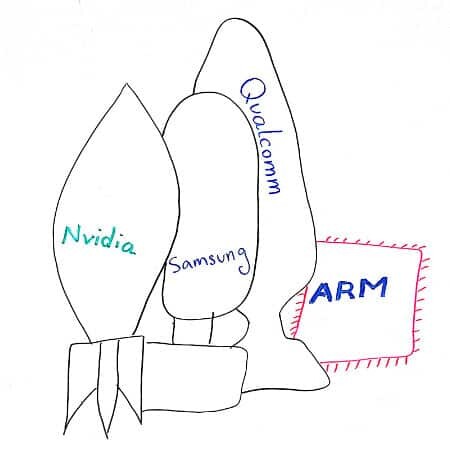It is an ARM’s race out there – one that involves mobile chipsets.
CES has come and gone, and we are now left with a lot of announcements to sift through.
For me, the most interesting part of it, looking from afar, were the new chipset announcements. What we see today is a literal ARMs race.
Yes, there’s Intel somewhere. I’ll treat them as the elephant in the room and just ignore them – they won’t be relevant in the mobile space in 2013 – it takes more time than that to gain the traction they need for their chipsets. What I will do, is go over the various announcements of ARM chipsets and see which angle each one is taking.
Things to note before we begin:
- Quad core. This is going to be the norm from now on in mobile devices. 4 cores, running in a phone. Best thing you can do with it? Multitasking (that’s running multiple apps at the same time smoothly). I don’t expect most apps to run multi-threaded in a way to make use of it.
- Cortex A-15. This is the latest ARM chip design and it is starting to get into our devices. Older ones still exist and get used, but this one is top of the line.
Qualcomm
Qualcomm replaced Intel this year in the keynote of CES, taking the torch of computing from the x86 architecture into the hands of ARM architecture.
During CES, Qualcomm unveiled their next Snapdragon chipsets. Both quad-core ARM architectures, running at 2.3 GHz and 1.9 GHz. While these numbers are lower than the competition (see below), Qualcomm does have a tendency of trying to find and squeeze the juice out of their chipsets in lower clock speeds than the rest of the pack – and with great success.
It is safe to assume these new chipsets re going to succeed in the market.
NVIDIA
Nvidia’s next chip is the Tegra 4. This one is another quad core chipset running at 2.6 GHz clock speed.
The difference with Nvidia? 72 (!) additional GPU cores that deal with your graphic needs.
Only thing I can think of here is gaming experience.
Samsung
Samsung introduced their next Exynos 8 Octa chipset. This one comes with 8 application cores: 4 running at 2.5 GHz clock speed and the other 4 running at 1.2 GHz. In both cases – it’s really fast.
This kind of a setting enables running at most times using the “slower” cores instead of the faster ones and providing the juice required when necessary. It allows putting a really powerful device that has log battery life for most use cases.
ST-Ericsson
ST-Ericsson, another chipset player in mobile has its own Quad core ARM system-on-chip. This one uses an older architecture than the rest – Coretex A9 instead of A15. The A9 is what you see in top of the line smartphones today, so it is rather powerful.
Not going for the latest architecture places ST-Ericsson in the mid-range of smartphones we will see launched.
Broadcom
Broadcom, a distinct player in the set-top box market decided to license ARM core technology. While Kevin C. Tofel sees this as a play towards smartphones by Broadcom, I think this talks of a totally different war at play.
Set-top boxes and TVs have used the MIPS chip architecture so far. Trying to sell them anything else – like ARM – was doomed to fail. But this is changing. Broadcom taking this step means the next generation of set-top boxes are going to be decidedly ARM based.
And the same is starting to happen in televisions – a place where low cost chipsets was the norm: Samsung unveiled a quad core chip in a TV – and yes… it is ARM based.
–
It seems we are ARMing ourselves rather well these days.


Yes, Intel still sucked the previous round and they are late with the release of their latest Atom chip.
Anandtech has been really busy trying to messure and compare:
http://www.anandtech.com/show/6422/samsung-chromebook-xe303-review-…
The latest ARM-chip beats the previous Intel Atom chip.
http://www.anandtech.com/show/6529/busting-the-x86-power-myth-indep…
The latest Intel-chip beats the older NVIDIA Tegra 3.
http://www.anandtech.com/show/6536/arm-vs-x86-the-real-showdown/14
I guess people are gonna be running/porting more Android and the like to settop boxes and TVs. Google owns the Motorola devision which deals with settop boxes so maybe it is partly their idea ?
I don’t think Motorola has anything to do with it.
The Smartphone movement was on ARM even in the Windows Mobile and Symbian days.
Apple iOS runs exclusively on ARM.
ARM has risen as the best solution for mobile devices because of several reasons:
I keep wondering what this will mean on the server. I guess SoC on the server is coming.
Because there is a similair race on the server in the a market that hardly exists today, the micro/high-density server market:
http://www.anandtech.com/show/6509/intel-launches-centerton-atom-s1200-family-first-atom-for-servers
Here are some predictions:
https://www.youtube.com/watch?v=njmQBqUuYqU
Server SoC is a different type of a challenge.
The main premise of having client SoC is that you buy thr exact SoC you are looking for – if it is for 3D graphics, media processing, video capturing, audio analysis, etc.
On hardware, it is all in the “cloud”, where you expect similar units of “computation”. Having there variety might not be the best of things – unless you have special use cases, the money to invest in it and the ROI model to fit.
First thing that SoC brings us is a lot less power, thus a lot more density, more workload per rack-unit in the datacenter. Diversity on the server isn’t all that much, when you have a large number of servers, you get to a point where you have a number of types of servers which fit certain workloads. But have a look at the video to get a good idea where it is probably going.